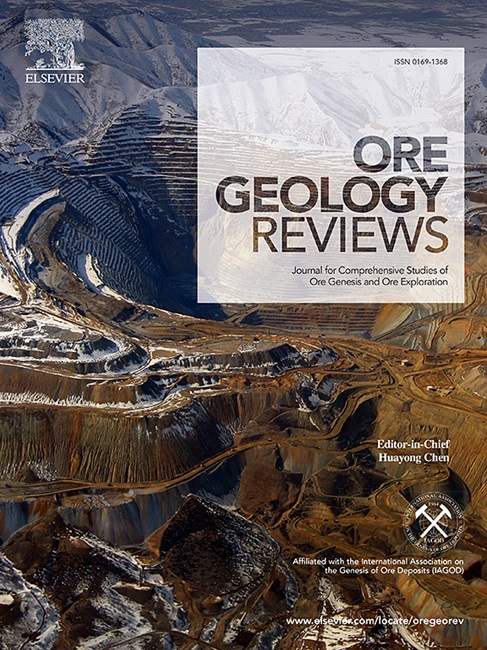摩谷变质带夕卡岩渐新世交代作用的原位维苏岩年代学测年
IF 3.6
2区 地球科学
Q1 GEOLOGY
引用次数: 0
摘要
大理岩中的流体交代作用(矽卡岩化)是缅甸Mogok变质带宝石形成和金属矿床的重要机制。然而,由于缺乏合适的矿物计时器,交代的精确时间是未知的。在本研究中,我们利用维苏岩U-Pb年代学和矿物化学来约束大理岩中流体交代的时间和反应流体的化学特征。选取了两种具有代表性的MMB钙硅酸盐岩,它们是方解石大理岩在渗流作用下的交代产物。研究了两种样品中维苏岩的赋存状态、纳米结构、U-Pb年龄和组成。MMB维苏岩在钙硅酸盐岩石中以卟绿岩和基质矿物的形式存在,与石榴石、斜辉石、斜长石和其他硅酸盐在结构上平衡,表明维苏岩在交代过程中生长。高角环形暗场扫描透射电子显微镜(HAADF-STEM)分析显示,维苏岩中没有富铀纳米级颗粒。激光烧蚀电感耦合等离子体质谱(LA-ICP-MS)分析两种样品的下截距年龄分别为29.8±1.8 Ma (2σ, MSWD = 2, n = 20)和29.6±2.0 Ma (2σ, MSWD = 1.5 Ma, n = 22)。这些年龄与MMB中正长岩年龄一致,表明反应流体极有可能与正长岩侵入有关。维苏岩中Th (80 ~ 2912 μg)、U (34 ~ 1603 μg)和lree (La为216 ~ 735 μg/g)的高富集度表明,反应流体将这些元素大量转移到大理岩中。研究表明,MMB中钙夕卡岩的交代形成发生在渐新世印亚辐合时期。我们强调,维苏岩是一种强大的矿物,可用于精确确定夕卡岩型矿石和宝石的时间,流体-碳酸盐相互作用和造山带CO2释放。本文章由计算机程序翻译,如有差异,请以英文原文为准。

Dating Oligocene metasomatism of skarns in Mogok metamorphic belt using in situ vesuvianite geochronology
Fluid metasomatism in marbles (skarnization) is a crucial mechanism for gemstone formation and metal deposits in the Mogok metamorphic belt (MMB, Myanmar). However, the precise time for the metasomatism is unknown due to a lack of suitable mineral chronometers. In this study, we use vesuvianite U–Pb chronology and mineral chemistry to constrain the timing of fluid metasomatism in marbles and the chemical characteristics of the reactive fluids. Two representative calc-silicate rocks from the MMB, which are the metasomatized products of calcite marbles by infiltrating fluids, were chosen. The occurrence, nanoscale structure, U–Pb ages, and compositions of vesuvianite in both samples were investigated. The MMB vesuvianite occurs as both porphyroblastic and matrix minerals in the calc-silicate rocks and is texturally equilibrium with garnet, clinopyroxene, plagioclase, and other silicates, indicating the growth of vesuvianite during metasomatism. The high-angle annular dark-field scanning transmission electron microscopy (HAADF-STEM) analysis reveals no U-rich nanoscale particles in the vesuvianite. Laser ablation inductively coupled plasma mass spectrometry (LA-ICP-MS) analysis yielded the well-defined lower intercept ages of 29.8 ± 1.8 Ma (2σ, MSWD = 2, n = 20) and 29.6 ± 2.0 Ma (2σ, MSWD = 1.5 Ma, n = 22) in the two samples. The ages are consistent with those of syenites in the MMB and thus reveal that the reactive fluids are most likely related to the syenite intrusions. The high concentrations of Th (80–2912 μg/g), U (34–1603 μg/g), and LREEs (216–735 μg/g for La) in the vesuvianite and high abundance of this mineral demonstrates that the reactive fluids transfer significant amounts of these elements into the marbles. This study indicates that the metasomatic formation of Ca-skarns in the MMB occurred in Oligocene during the India-Asia convergence. We highlight that vesuvianite is a powerful mineral that could be used for accurately determining the timing of skarn-type ores and gemstones, fluid-carbonate interaction, and orogenic CO2 release.
求助全文
通过发布文献求助,成功后即可免费获取论文全文。
去求助
来源期刊

Ore Geology Reviews
地学-地质学
CiteScore
6.50
自引率
27.30%
发文量
546
审稿时长
22.9 weeks
期刊介绍:
Ore Geology Reviews aims to familiarize all earth scientists with recent advances in a number of interconnected disciplines related to the study of, and search for, ore deposits. The reviews range from brief to longer contributions, but the journal preferentially publishes manuscripts that fill the niche between the commonly shorter journal articles and the comprehensive book coverages, and thus has a special appeal to many authors and readers.
 求助内容:
求助内容: 应助结果提醒方式:
应助结果提醒方式:


